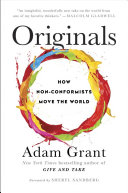

In 'Originals', Adam Grant emphasizes the significance of non-conformity in driving innovation and change. Non-conformists challenge the status quo and are often the ones who introduce fresh ideas that can transform industries and societies. Grant illustrates this concept by citing various examples from history, including figures like Martin Luther King Jr. and Steve Jobs, who dared to think differently and take risks. The book argues that non-conformity is not merely about being rebellious; it involves a deep understanding of societal norms and the courage to deviate from them when necessary. This idea encourages readers to embrace their unique perspectives, fostering an environment where creativity and innovation can flourish. Non-conformity is portrayed as a vital trait for anyone looking to make a significant impact in their field, whether in business, technology, or social movements.
Continue readingGrant discusses how fear can be both a hindrance and a motivator for creativity. On one hand, fear of failure can stifle innovative thinking and prevent individuals from pursuing their original ideas. On the other hand, a healthy dose of fear can push individuals to refine their ideas and work harder to achieve their goals. Grant introduces the concept of 'strategic procrastination', where delaying a decision can lead to better outcomes, as it allows for more time to evaluate risks and refine ideas. This nuanced understanding of fear encourages readers to recognize their fears and use them as tools for growth rather than obstacles to their creativity.
Continue readingCollaboration is another key theme in 'Originals'. Grant highlights how working with diverse teams can lead to more innovative solutions. He provides examples from various industries where collaboration has led to groundbreaking ideas and products. The book posits that when individuals with different backgrounds and perspectives come together, they can challenge each other's assumptions and spark new ideas. Grant advocates for creating environments that promote collaboration, as this not only leads to better outcomes but also fosters a culture of originality. This idea is especially relevant in today's interconnected world, where cross-disciplinary collaboration is often essential for success.
Continue readingGrant emphasizes the importance of recognizing original ideas and nurturing them to fruition. He discusses the role of leaders in identifying potential within their teams and providing the support needed to develop those ideas. The book outlines strategies for leaders to create a culture that values experimentation and tolerates failure, which is crucial for innovation. Grant argues that organizations should encourage employees to voice their ideas and provide platforms for experimentation. This idea is particularly relevant for managers and leaders who wish to cultivate a creative workforce that can drive their organizations forward.
Continue readingWhile the book champions originality, Grant also discusses the importance of balance between being original and conforming to certain norms. He explains that while it's essential to challenge the status quo, there are times when conforming can be beneficial. For instance, understanding the existing frameworks and norms can help innovators navigate their environments more effectively. Grant suggests that the most successful originals are those who know when to conform and when to diverge. This nuanced perspective encourages readers to assess their situations critically and make informed decisions about when to stand out and when to fit in.
Continue readingTiming plays a crucial role in the success of original ideas, according to Grant. He discusses how the context in which an idea is presented can significantly affect its reception. The book provides examples of inventions and movements that succeeded or failed based on their timing. Grant argues that understanding the social and cultural climate is essential for innovators to position their ideas effectively. This insight encourages readers to be mindful of the timing of their proposals and to adapt their strategies accordingly, enhancing the likelihood of their ideas gaining traction.
Continue readingGrant highlights the importance of learning from failure as a critical component of the creative process. He argues that many successful originals have experienced significant setbacks but have used those experiences to refine their ideas and approaches. The book provides practical strategies for reframing failure as a learning opportunity rather than a defeat. This perspective encourages readers to adopt a growth mindset, viewing challenges as stepping stones to success rather than insurmountable obstacles. By embracing failure as part of the journey, individuals can cultivate resilience and continue to pursue their original ideas.
Continue reading